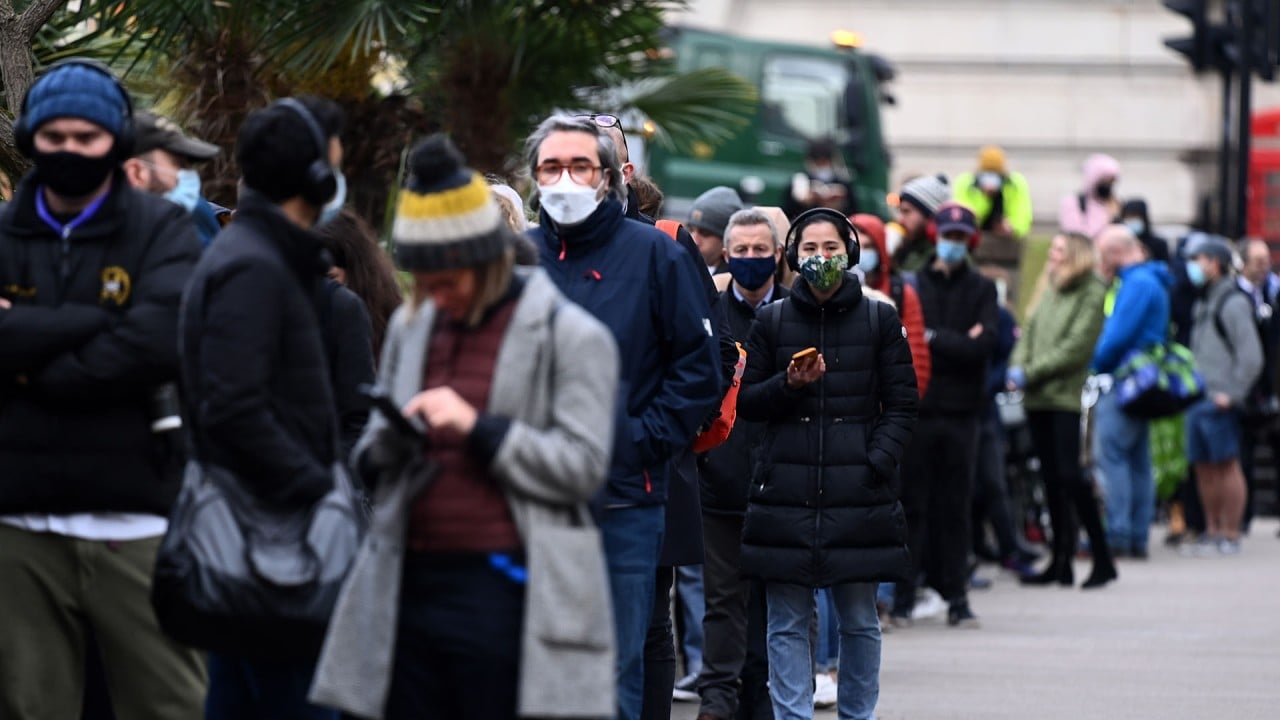
Why the rapid spread of ‘mild’ Omicron is cause for alarm
- The coronavirus variant’s high rate of transmission has scientists worried that health care systems will be overwhelmed
- They also warn it is still too early to tell how dangerous the latest strain of the virus may be to vulnerable groups
But along with the high rate of transmission, Omicron appears to bring seemingly less severe clinical outcomes.
In South Africa, ground zero for Omicron, early findings suggested the variant may cause less severe illness. So far only one death has been directly linked to Omicron, recorded in Britain, and symptoms appear to be mild.
In addition, 10 out of 4,713 cases due to Omicron in Britain as of Monday were hospitalised and all 1,686 Omicron cases reported by the European Union CDC, also as of Monday, were either asymptomatic or mild.
But scientists cautioned it was too early to conclude that Omicron would make people less sick – with case numbers too low, limited data, and its impact on the population not fully represented.
Even if Omicron is eventually confirmed to cause less severe illness, a variant more transmissible than Delta will not be a blessing but a threat, they said.
Virologist Ian Mackay, associate professor at Australia’s University of Queensland, said the Omicron variant appears to transmit more effectively than Delta because it overpowers or pushes out Delta in places where it is circulating.
Although current data suggests Omicron does not seem to cause more severe disease than Delta, early findings from South Africa showed those who needed oxygen support were unvaccinated, making the new variant’s fast spread by no means good news.
“Even if less likely to cause severe diseases or more virulent, it will still cause lots of cases to go to hospital. We just need to remember that even small percentages of highly viral cases still add up to big numbers when we see lots of cases overall,” Mackay said.
“If we suddenly have another wave around the world of Omicron, those people who are unvaccinated, those who have become less immune over time since their vaccinations and yet to get their third doses, and the elderly whose vaccination immunity may have started waning, they could all be at risk of the disease.”
Omicron-stricken South Africa saw Covid-19 case numbers rise to 18,035 on Sunday, compared to 1,275 on November 24, when the variant was first reported in the country.
As Omicron looms, Africa battles to get vaccine shots in arms
The reproductive number of the virus – which shows how many people are likely to be infected by one person – is currently 2.5, higher than at any prior point in the pandemic.
Increasing rates of hospitalisation were recorded, possibly due to increasing overall numbers of people becoming infected, according to the South African health ministry.
Meanwhile, the number of Omicron cases is doubling every two to three days in Britain and is expected to soon become the dominant strain, the country’s health security agency has predicted.
Without restrictions, Omicron cases are expected to increase to 200,000 a day by the end of the month in Britain, while hospitalisations could double over the next two weeks, it said, as authorities called for residents to get booster shots as protection against the new strain.
Denmark is seeing the number of Omicron infections double every second day and the Statens Serum Institut estimates it will become the dominant Covid-19 variant this week, potentially increasing pressure on hospitals.
It is not entirely clear why the Omicron variant is so efficient at transmission. Its mutation of the coronavirus spike protein – which plays a key role in infection – both increases its ability to infect non-immune hosts and improves immunity escape. But scientists are still unsure whether one or both factors are in play.
Various studies have suggested Omicron could evade the immunity provided by vaccination or prior infection, following cases among patients who were not only fully vaccinated but had also recently received a booster shot.
Kwok Kin-on, a public health epidemiology professor from Chinese University of Hong Kong, said data on the severity of cases needed careful study, with Omicron likely to be associated with a risk of reinfection three to eight times higher than Delta.
Sinovac shot too weak to beat Omicron, Hong Kong study shows
A variant with more ability to cause reinfection could lead to many more mild cases of the disease, he said. “It can push down the percentage of severity among infections, so we have to be careful in calculating the percentage of severity infection.”
The “small percentage, big number” issue is particularly problematic when it comes to Omicron with its super-efficient transmission.
Michael Plank, a professor from the University of Cambridge’s School of Mathematics and Statistics, who specialises in epidemiological modelling, said that while a milder illness was better, it was alarming to be dealing with a variant that clearly spreads faster than Delta.
“If it’s able to spread significantly faster than Delta, then that is a problem because it could end up infecting far more people. A small percentage of a much bigger number ending up in hospital could still cause serious problems for health care systems that are already stretched by Delta,” he said.
Of all the key biological traits that need to be understood about the Omicron variant – how efficiently it spreads, how effectively it evades immunity, and the severity of the illness it causes – it is the latter which appears most deceiving and will need time and data to understand.
Peter Chin-Hong, professor of medicine specialising in infectious diseases with the University of California San Francisco, said early data on Omicron’s emergence in South Africa needed to be interpreted with caution.
South Africa’s demographics – with a mean age of 27 and about 60 to 80 per cent of its adult population infected – may have contributed to the apparently mild symptoms observed initially, he said.
“South Africa may be very different from many other countries and geographical regions. It has a generally young population and, apart from HIV infection, not as many other immunocompromised patient populations or people with medical comorbidities as other countries like the United States,” Chin-Hong said.
“The country was hit hard by successive waves of Covid-19, so mild symptoms may be a function of having some immunity.”
In contrast, other countries may have less built-up immunity and larger populations of vulnerable groups, including the elderly, immunocompromised, infants, and people with medical comorbidities.
Kwok, from CUHK, also cautioned that more data would be needed to fully understand how Omicron affects different age groups, especially given the link between age, vaccination eligibility and immunity.
The true impact of the variant would take time to unfold, as hospitalisations and deaths from the coronavirus often take weeks to occur, he said.
“There are still three to four weeks of lag between infection and death. It is still positive that [there are no] large numbers of death cases yet, but … you have to wait one to two weeks to see whether the death rate remains stable.”
Mackay, from the University of Queensland, said that without solid evidence of Omicron’s virulence, there was no guarantee that having a mild version of the highly transmissible virus circulating would end the pandemic.
“You have to be talking about very mild and that’s why it is wishful thinking because it’s unlikely that the virus doesn’t cause any severe diseases. There is a risk of just letting it go and hoping it continues to be mild because it will probably cause some cases and those small numbers will add up,” Mackay said.
“I think we have to be very careful when we say, let’s hope that Omicron is a mild disease and that everybody gets a mild disease because it’s unlikely. Some will suffer.”



